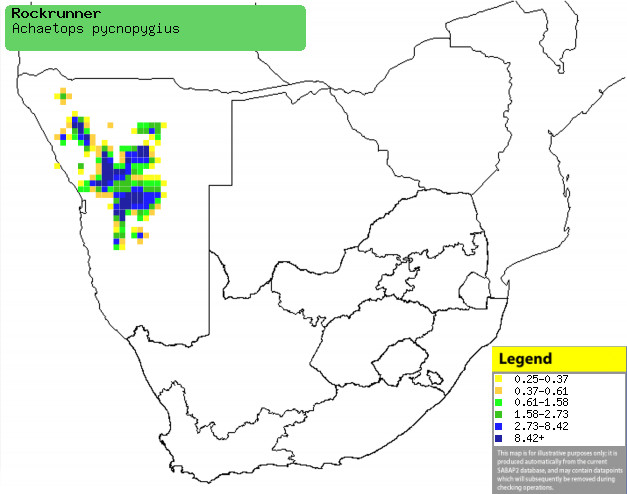|
Achaetops pycnopygius
(Rockrunner)
RotsvoŽl [Afrikaans]; Roodstuit-rotszanger [Dutch];
Achťtopse ŗ flancs roux [French]; Klippensšnger, Damara-felsenspringer
[German]; Salta-pedras [Portuguese]
Life
> Eukaryotes >
Opisthokonta
> Metazoa (animals) >
Bilateria >
Deuterostomia > Chordata >
Craniata > Vertebrata (vertebrates) > Gnathostomata (jawed
vertebrates) > Teleostomi (teleost fish) > Osteichthyes (bony fish) > Class:
Sarcopterygii (lobe-finned
fish) > Stegocephalia (terrestrial
vertebrates) > Tetrapoda
(four-legged vertebrates) > Reptiliomorpha > Amniota >
Reptilia (reptiles) >
Romeriida > Diapsida > Archosauromorpha > Archosauria >
Dinosauria
(dinosaurs) > Saurischia > Theropoda (bipedal predatory dinosaurs) >
Coelurosauria > Maniraptora > Aves
(birds) > Order: Passeriformes
> Family: Sylviidae
Distribution and habitat
Near endemic to southern Africa, with its population
centered on west-central Namibia, extending marginally into Angola. It is fairly
common yet localised, generally preferring hillsides, scree slopes and rocky
outcrops.
|
 |
|
Distribution of Rockrunner in southern Africa,
based on statistical smoothing of the records from first SA Bird Atlas
Project (©
Animal Demography unit, University of
Cape Town; smoothing by Birgit Erni and Francesca Little). Colours range
from dark blue (most common) through to yellow (least common). |
Food
It does almost all of its foraging on the ground, pretty
much exclusively eating invertebrates, such as grasshoppers and caterpillars.
Breeding
- The nest is an open cup built of grass of various lengths, with fine grass
stems in the inside and more coarse stems on the outside. It is typically
woven into the center of a large grass tuft, only visible from above.
- Egg-laying season is from November-March.
- It lays 2-3 eggs, usually 3 eggs, which were incubated for 15 in one
observation.
- The chicks are fed by both adults, leaving the nest before they can fly
and hiding in the nearby vegetation and rocks.
Threats
Not threatened.
References
-
Hockey PAR, Dean WRJ and Ryan PG 2005. Roberts
- Birds of southern Africa, VIIth ed. The Trustees of the John Voelcker
Bird Book Fund, Cape Town.
|
